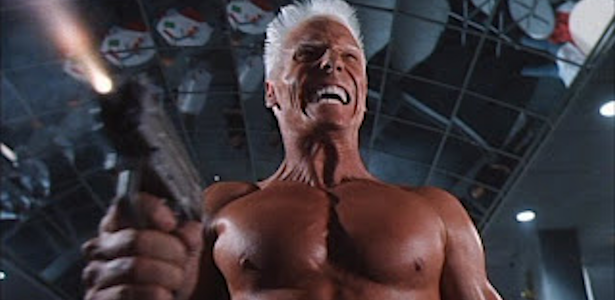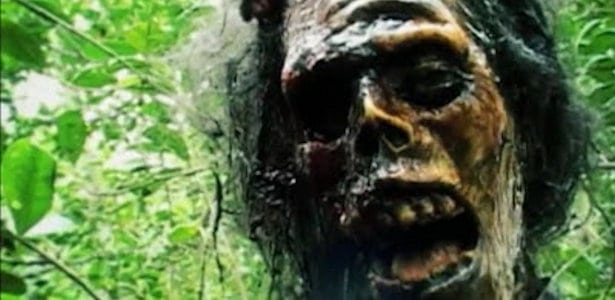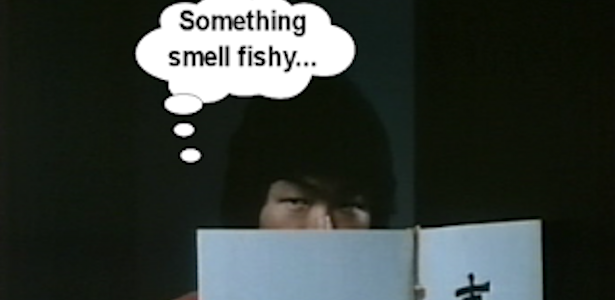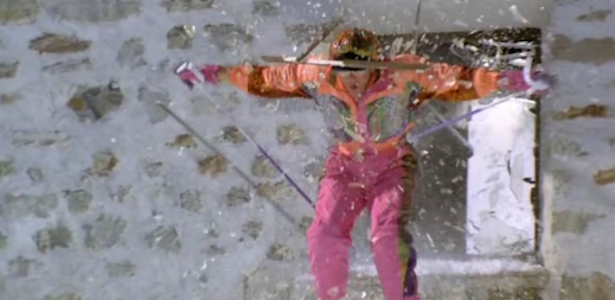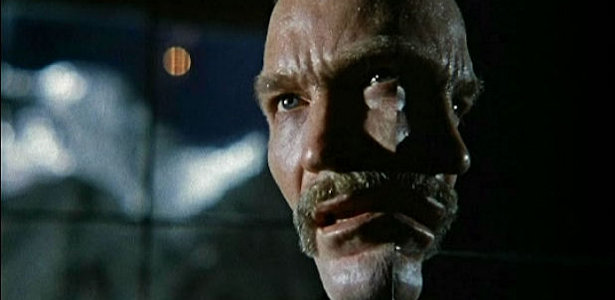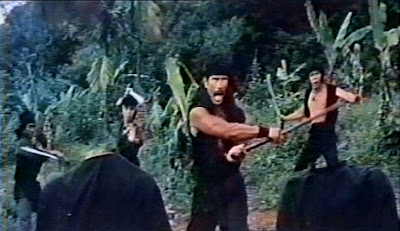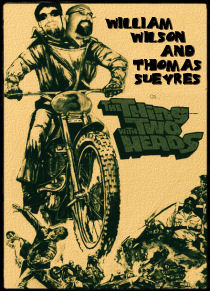More recently we’ve had ICHI (2008), a low-budget Japanese, direct to video, anime inspired effort that sports acting, writing and action that is suitable for a highschool play. A young blind female shamisen player (Haruka Ayase) is searching for her mentor, Zatoichi, by way of a crime boss who allegedly dueled with him and lived to tell the tale. Monumental willpower is required to both make it through the film’s pointlessly bloated 120 minute running time and to suspend your disbelief that a skinny young girl could actually lift a sword, much less kill anyone with it. Though we don’t have to worry about the latter too much as rarely does she bother to actually engage in such acts, preferring to let her craven admirer (Shido Nakamura) do the work. Or she would if he could actually pull out his sword which he is unable to do due to a traumatic event in which he accidentally killed someone. This character has been done many times before and far better, but wouldn’t be so bad if this lead to amazing fight scenes with Ichi. Hell, the blind swordswoman Oichi would have kicked this chick’s ass every day of the week and twice on Sunday. Unfortunately it appears this film was far too budget strapped to be able to afford a choreographer and fumbles through its brief fight scenes with less precision than a couple of teens at a renaissance fair. There’s no bloodletting to speak of, the few people that are killed, die with one sword stroke, no blood, their clothes intact. The acting is way over the top with lots of bulging eyes, shouting and amateur theatrics. If you are the type who is obsessed with live-action anime, no matter how cheap, this might be for you, otherwise keep moving, there’s nothing to see here.
Much to my surprise this year we discovered that the Hughes brothers were fans of Katsu’s blind swordsman, and “Fallout 3” as well. No point in dwelling on this movie as there is so many write-ups already on the web, but the basic premise of THE BOOK OF ELI (2010) is a lone wanderer Eli (Denzel Washington) is carrying a book through a post-apocalyptic America while fending off radiation-infected scavengers and a being doggedly pursued by a psychotic, power-monger (Gary Oldman, playing true to type) and who by hook or by crook is going to get that book with the help of his lackey (Ray Stevenson, somewhat wasted in this role, but nice to see anyway).
 One of the odd things about the movie is there is a legthy, stunningly atmospheric opening sequence that is completely different from the rest of the film. While the body of the film apes the sepia wash from the PC game “Fallout 3”, the opening sequence is bathed in a greenish fog and is noticeably stylistically different. In fact it is so good, that it makes the rest of the film somewhat disappointing in as that it is much more straightforward and never returns to that claustrophobic, almost gothic horror, atmosphere.
One of the odd things about the movie is there is a legthy, stunningly atmospheric opening sequence that is completely different from the rest of the film. While the body of the film apes the sepia wash from the PC game “Fallout 3”, the opening sequence is bathed in a greenish fog and is noticeably stylistically different. In fact it is so good, that it makes the rest of the film somewhat disappointing in as that it is much more straightforward and never returns to that claustrophobic, almost gothic horror, atmosphere.
 One of the odd things about the movie is there is a legthy, stunningly atmospheric opening sequence that is completely different from the rest of the film. While the body of the film apes the sepia wash from the PC game “Fallout 3”, the opening sequence is bathed in a greenish fog and is noticeably stylistically different. In fact it is so good, that it makes the rest of the film somewhat disappointing in as that it is much more straightforward and never returns to that claustrophobic, almost gothic horror, atmosphere.
One of the odd things about the movie is there is a legthy, stunningly atmospheric opening sequence that is completely different from the rest of the film. While the body of the film apes the sepia wash from the PC game “Fallout 3”, the opening sequence is bathed in a greenish fog and is noticeably stylistically different. In fact it is so good, that it makes the rest of the film somewhat disappointing in as that it is much more straightforward and never returns to that claustrophobic, almost gothic horror, atmosphere. While I did enjoy the film, there’s an awful lot of stuff that bugged me about it things that kept the film from being a true classic of the genre. Not the least of which is the fact that the film borrows bits and pieces of other media, if not it's entire visual style. You could make the argument that it is lifting visual cues from speghetti westerns (which is true), but more so, Eli is a homogenization of Shintaro Katsu and Tony Anthony on a Jesus trip. Katsu’s fighting style is on display early on when Eli reveals his preferred fighting implement, a custom sword, while neatly carving up some irradiated ambushers, and, arguably, Tony Anthony’s dogged determination, laconic attitude and casual quips. Also, honestly there is no arguing the clear inspiration for the American wasteland as it is lifted, nearly verbatim from the “Fallout” PC games, in particular “Fallout 3”.
While I did enjoy the film, there’s an awful lot of stuff that bugged me about it things that kept the film from being a true classic of the genre. Not the least of which is the fact that the film borrows bits and pieces of other media, if not it's entire visual style. You could make the argument that it is lifting visual cues from speghetti westerns (which is true), but more so, Eli is a homogenization of Shintaro Katsu and Tony Anthony on a Jesus trip. Katsu’s fighting style is on display early on when Eli reveals his preferred fighting implement, a custom sword, while neatly carving up some irradiated ambushers, and, arguably, Tony Anthony’s dogged determination, laconic attitude and casual quips. Also, honestly there is no arguing the clear inspiration for the American wasteland as it is lifted, nearly verbatim from the “Fallout” PC games, in particular “Fallout 3”.I don't know who put these screen comparisons together, but they are actually only a small representation of the amazing similarities.
The landscapes are cribbed right out of the “Fallout” concept art and the ending sequence is undeniably fashioned after the Citadel HQ at the end of “Fallout 3”. The main difference here being where the “Fallout” games had kischy fictional ‘50s-style product placement and brand-names, here we have so much real product placement that it verges on being laughable. Everything from Busch Beer and KFC to Motorola and GMC are prominently displayed with as much subtlety as Johnny Carson hawking Virginia Slims in the middle of the “Tonight Show” back in the ‘70s. KFC is treated with almost as much reverence as The Holy Book, which is an amusing irony as the employees of Yum Brands privately refer to their three big brands (KFC, Pizza Hut and Taco Bell) as “The Unholy Trinity”.
 Speaking of religion, the “you people need churchin’ up” message of the film would have been served better if it wasn’t so heavy handed and preachy. Not ten minutes goes by without some sort of Big Christian Message. The last thing you see of Eli is so overt that it’ll take only the most devout to resist snickering out loud. Now I'm not one of those atheist activists who have nothing better to do than whip themselves into a frenzy because the word "God" appears on American currency, but at the same time there is nothing more annoying than some born-again Jesus freak getting in your face while you are trying to pump gas and telling you how you are going to hell and will be damned forever because you don't go around waving bibles in people's faces while they are pumping gas. There are a lot of great movies that have religious subtext and many science fiction stories are heavily allegorical. It's all about subtlety. Yes, even a movie loaded to the gills with paramilitary hardware can be subtle in the plot department. Add to that the final sequence that sets up Mila Kunis as the star of a sequel that with any luck will never see the light of day and you’ve got quite a mixed bag. Even so it is still one of the best reworkings of both the Zatoichi mythos and the Western genre in years. Then again, I guess that's not really saying much.
Speaking of religion, the “you people need churchin’ up” message of the film would have been served better if it wasn’t so heavy handed and preachy. Not ten minutes goes by without some sort of Big Christian Message. The last thing you see of Eli is so overt that it’ll take only the most devout to resist snickering out loud. Now I'm not one of those atheist activists who have nothing better to do than whip themselves into a frenzy because the word "God" appears on American currency, but at the same time there is nothing more annoying than some born-again Jesus freak getting in your face while you are trying to pump gas and telling you how you are going to hell and will be damned forever because you don't go around waving bibles in people's faces while they are pumping gas. There are a lot of great movies that have religious subtext and many science fiction stories are heavily allegorical. It's all about subtlety. Yes, even a movie loaded to the gills with paramilitary hardware can be subtle in the plot department. Add to that the final sequence that sets up Mila Kunis as the star of a sequel that with any luck will never see the light of day and you’ve got quite a mixed bag. Even so it is still one of the best reworkings of both the Zatoichi mythos and the Western genre in years. Then again, I guess that's not really saying much.Now we have the impending Japanese and French co-production ZATOICHI: THE LAST (2010) which is being produced by Toho who has obtained the rights to the francise and has stated that no more Zatoichi films will be made after this one. Pretty sure we've heard that one before (*cough* GODZILLA VS. THE DESTROYER *cough*). Starring cheesy teen idol Shingo Katori of SUKIYAKI WESTERN DJANGO (2007) and THE ADVENTURES OF SUPER MONKEY (2007), the trailer looks a million times better than the last two remakes, but if nobody’s going to even try to do these classic films justice any more, I sincerely hope it really is the last. And no, we won’t be talking about that Punkin’ Headed Freak and his Thugstein producers.




